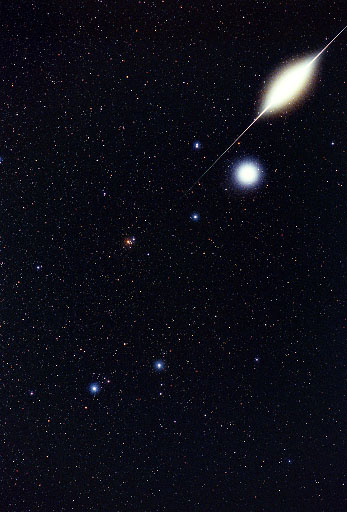Iridium Flare in Lyra

|
| Date: | 08.08.1999 | Time: | 1:47 UT | Exposure: | 5 min |
|---|---|---|---|---|---|
| Field of View: | 10o x 15o | Emulsion: | Kodak Royal Gold 400 Select | Filter: | none |
| Instrument: | f=135mm, 1/2.8 | Place: | Hoher List | Observer: | T. Credner, K. Bagschik |

|
| Date: | 08.08.1999 | Time: | 1:47 UT | Exposure: | 5 min |
|---|---|---|---|---|---|
| Field of View: | 10o x 15o | Emulsion: | Kodak Royal Gold 400 Select | Filter: | none |
| Instrument: | f=135mm, 1/2.8 | Place: | Hoher List | Observer: | T. Credner, K. Bagschik |
Since 1997 a total number of 66 satellites from the Iridium family were launched and did start their job in a lower earth orbit. They each have three flat antennas all about the size of a door and due to their silver coating they are perfect mirrors. When reflecting the sunlight to an observer they can flare up as dazzling objects, reaching up to -8 mag in the night sky. The above image shows such a bright flare in the constellation of the Lyre.
Normally such artificial light pollution by satellites is quite annoying to astronomers, but the visual observation can be quite impressive. And above exposure gives a unique and interesting comparison of two of our most important astronomical standard stars: Vega (alpha Lyrae) and our Sun ! In comparing the brightness with the 0 mag star Vega you have to take the movement of the satellite into account. Vega was exposed for five minutes while the satellite just took about ten seconds for its visible path. Blue appearing Vega represents the spectral type A 0. Such A 0 stars define the zero point of many astronomical filter systems, for example the Johnson-Cousins UBVRI system: U = B = V = R = I for A 0 stars. The color temperature of Vega is about 15000oK whereas our sun is of spectral type G 2 and has a "cooler" color temperature of about 7000o. You can easily see the color difference to Vega in the image. Sunlight is often taken as standard white for a natural RGB (Red Green Blue) color system, especially for daylight photography. But also many CCD amateur astrophotographers calibrate their color balance with sunlight, whereas the above flare shows up in a yellow tinge (my personal visual impression was more a green). But thin clouds have influenced the observations and acted as a kind of diffuser which probably also has some influence to the visible color.